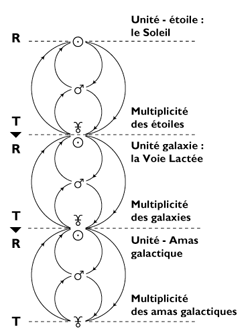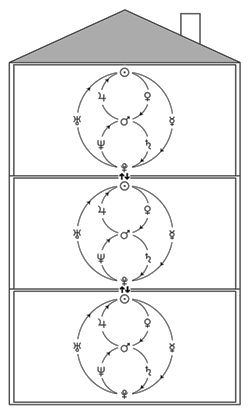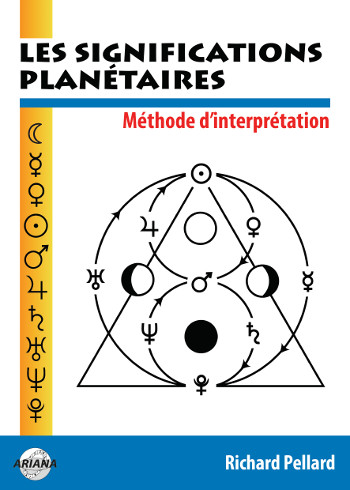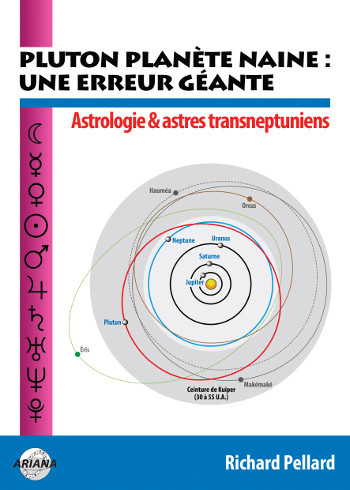Your Planets
Portraits of the Planets
Aspects between Planets
The planetary ages
The planetary families
Planets in Signs
The Planets in comics


The interpretation examples that we are suggesting are very far from being exhaustive: they only show and outline a general frame describing the issues of the planetary family. They should therefore not be taken literally. Each being brings indeed its own responses, more or less original, to the questions raised by a planetary family. There is no magic formula. Through using the R.E.T. and the Theory of Ages and combining logic, observation and imagination, you will be able to develop a thousand other possible meanings, a thousand other variations on the same theme.
The Sun-Pluto couple occupies a special position: its nature therefore deserves in-depth investigation. These two stars indeed occupy the extremities of the solar system. Extreme center for the Sun, extreme periphery for Pluto… Beyond these two limits, it is the opening on the unknown: internal unknown of the Sun, external unknown of Pluto. This is how extremes meet. Sun and Pluto close and delimit the field of the solar system.
 Every organized system is characterized by a center and a periphery; and every system is itself part of a larger system. In the solar system, the Sun (‘rR’, maintaining the unique) is the central unit, center of gravity and obligatory reference. But this unique Sun (‘rR’) is only ever one of the billions of stars that make up our galaxy, the Milky Way. A star quite average in size and brilliance… The basic unit of the solar system is only an anonymous and insignificant (“non-R”) element within the plutonian multitude (‘tT’, maintenance of the multiple) of the stars in the galaxy.
Every organized system is characterized by a center and a periphery; and every system is itself part of a larger system. In the solar system, the Sun (‘rR’, maintaining the unique) is the central unit, center of gravity and obligatory reference. But this unique Sun (‘rR’) is only ever one of the billions of stars that make up our galaxy, the Milky Way. A star quite average in size and brilliance… The basic unit of the solar system is only an anonymous and insignificant (“non-R”) element within the plutonian multitude (‘tT’, maintenance of the multiple) of the stars in the galaxy.
We could go on forever. The Milky Way then becomes a simple unit of measurement: it is a galaxy. Ours. But the galaxies themselves are grouped into galactic superclusters. The one of which the Milky Way is a part is the Virgo supercluster. At this level, our brilliant and “unique” Sun is only one of many (‘tT’) anonymous and insignificant dust located on the periphery of the galaxy to which it belongs, which is only an anonymous and insignificant dust of the supercluster, which … etc. At each change in level of organization, we change the unit of measurement (‘rR’). The unique of a given system (‘rR’) is transformed into one of the elements of the multitudes (‘tT’) which make up another larger system. This is called referential changes.
 Let’s take another example to illustrate these changes of frame of reference: the description of the functioning of the human brain.
Let’s take another example to illustrate these changes of frame of reference: the description of the functioning of the human brain.
Level 1: “Quantum structure of atoms”. At this level, the unit of reference (‘rR’) is the atom.
Level 2: “Molecular structure of the chemical substances that compose it.” The atom, the “solar” unit of the previous level, is now only one of the multiple (plutonian) elements that make up the molecule.
Level 3: “Aspect of its individual cells under the electron microscope”. The cell is the unique center of interest (‘rR’). The multiple (‘tT’) molecules of which it is made are reduced to insignificance.
Level 4: “Behavior of its neurons as an interacting system.” The unit of reference is this time the functional unit represented by the nerve cells (neurons) in mutual relations. The neuron, essential unit of level 3, has only a minor interest.
Needless to comment on the complete list of these changes of level of organization which induce changes of frame of reference, where the Sun of one level becomes the Pluto of another, and vice versa. I still give you, without comment, the rest of this list:
Level 5: “History of the evolution of these neurons as structures evolving over time.”
Level 6: “Behaviour-response of the individual whose brain is in reference: Set of elements forming a reference system; all the elements related to this system” (Larousse).
Level 7: “Social or family environment of this human being.”
Level 8: etc.
To which we can and must add the cosmic environment of this human being… and so we come back to astrology and the interpretation of the Sun-Pluto relationship. Unity can be transformed into multiplicity, and vice versa: Pluto is the Sun of another frame of reference, and the Sun becomes plutonian by changing level. It follows that “the planets, celestial objects instigating our functions, (are not) identifiable with them”.
Within a given system, the solar function encourages us to maintain a central, unique, simple, ultra-representative point of view of this system: this is its fundamentally conservative aspect. In this same system, the plutonian function encourages us to challenge this system of reference and to seek others elsewhere. In this sense, the solar function above all awakens our simplifying functions, and the plutonian function our complexifying functions. But if, during his evolution, an individual radically shifts his references, everything changes.
The sun “becomes plutonian when we go beyond our reductive patterns”, and the being strongly marked by the solar function, by becoming sensitive to the multiplicity of which he knows that he is only one of the elements, can find himself disturbed in his functioning, seeking for example “the approval of a consensus by the criticism he makes of it… he is strong and fragile, desirous of power in order to escape it, uncomfortable in his masks… he does not give up appearing but wants to appear as he is. The stranger from above has a voice strong enough to prevent him from taking himself seriously, it is not strong enough to discourage him from being the first”. One more degree, and “the consensus is lost. Prophetic sun or simple clairvoyant… it no longer bases its power on the present. Primitive or downgraded from a higher frame of reference, he perceives above all in what and how a consensus generates this waste which is, in his eyes, the true values. This one is an irrecoverable misfit, or a revolutionary, creator of new tables or good at overthrowing established ones” (J.-P. Nicola).
Of course, it is essential that the individual has experienced a major mutation, a radical metamorphosis of his reference systems to thus live his solar function… which is rare. When interpreting the chart of an individual in whom the Sun is dominant, it is safer to stick a priori to the meanings “classics” of this planet.
In his reference system “usual”, an individual strongly marked by the plutonian function tends to contest or reject the legitimacy of solar laws, models, references and consensus. He takes to the maquis in the anarchy of the multiple to criticize the order of the unique. What happens when he becomes sensitive to his solar dimension, when he discovers in the maquis of the multiple the roots of another unity? The resulting destabilization of the plutonian function can make him a “unstable marginal… who asks only to be recovered but who, conquered glory, remains nonetheless half refractory. It oscillates on the borders, sometimes inside, sometimes outside… In this formula of in-between, an entire existence can flow in ambiguous situations, or in roles of official marginality”. One degree more, and Pluto becomes Sun. The “plutonian” individual then has this “secret hearth, this fire of the sources which allows the discoverers to take the snubs… The one who wears this Sun has an indestructible center. He is at the south of the antipodes, the next day under the Earth. It is not hope that sustains it but necessity” (J.-P. Nicola).
As for the Sun, this interpretation of Pluto should be reserved for rare cases, the fruit of profound mutations. The plutonian all-comer is maintained, wanders or delights in the jungles of the multiple.
▶ The Solar: Psychological profile
▶ The solar function ‘rR’ (representation of Representation)
▶ The plutonian function ‘tT’ (transcendence of Transcendence)
▶ Powers of Sun-Moon: the Sun
▶ Apollon et son ombre : quand le Soleil se fait violence
▶ Solar stage (from 7 1/2 months to 1 year old): the age of identification
▶ Plutonian stage (from 164 to 248 years old): the age of disappearance
▶ Sun-Mars-Pluto: extensive Power
▶ Sun-Mercury-Venus: extensive Representation
▶ Sun-Jupiter-Uranus: intensive representation

Les significations planétaires
par
620 pages. Illustrations en couleur.
La décision de ne traiter dans ce livre que des significations planétaires ne repose pas sur une sous-estimation du rôle des Signes du zodiaque et des Maisons. Le traditionnel trio Planètes-Zodiaque-Maisons est en effet l’expression d’une structure qui classe ces trois plans selon leur ordre de préséance et dans ce triptyque hiérarchisé, les Planètes occupent le premier rang.
La première partie de ce livre rassemble donc, sous une forme abondamment illustrée de schémas pédagogiques et tableaux explicatifs, une édition originale revue, augmentée et actualisée des textes consacrés aux significations planétaires telles qu’elles ont été définies par l’astrologie conditionaliste et une présentation détaillée des méthodes de hiérarchisation planétaire et d’interprétation accompagnées de nombreux exemples concrets illustrés par des Thèmes de célébrités.
La deuxième partie est consacrée, d’une part à une présentation critique des fondements traditionnels des significations planétaires, d’autre part à une présentation des rapports entre signaux et symboles, astrologie et psychologie. Enfin, la troisième partie présente brièvement les racines astrométriques des significations planétaires… et propose une voie de sortie de l’astrologie pour accéder à une plus vaste dimension noologique et spirituelle qui la prolonge et la contient.
Téléchargez-le dès maintenant dans notre boutique

Pluton planète naine : une erreur géante
par
117 pages. Illustrations en couleur.
Pluton ne fait plus partie des planètes majeures de notre système solaire : telle est la décision prise par une infime minorité d’astronomes lors de l’Assemblée Générale de l’Union Astronomique Internationale qui s’est tenue à Prague en août 2006. Elle est reléguée au rang de “planète naine”, au même titre que les nombreux astres découverts au-delà de son orbite.
Ce livre récapitule et analyse en détail le pourquoi et le comment de cette incroyable et irrationnelle décision contestée par de très nombreux astronomes de premier plan. Quelles sont les effets de cette “nanification” de Pluton sur son statut astrologique ? Faut-il remettre en question son influence et ses significations astro-psychologiques qui semblaient avérées depuis sa découverte en 1930 ? Les “plutoniens” ont-ils cessé d’exister depuis cette décision charlatanesque ? Ce livre pose également le problème des astres transplutoniens nouvellement découverts. Quel statut astrologique et quelles influences et significations précises leur accorder ?
Enfin, cet ouvrage propose une vision unitaire du système solaire qui démontre, chiffes et arguments rationnels à l’appui, que Pluton en est toujours un élément essentiel, ce qui est loin d’être le cas pour les autres astres au-delà de son orbite. Après avoir lu ce livre, vous saurez quoi répondre à ceux qui pensent avoir trouvé, avec l’exclusion de Pluton du cortège planétaire traditionnel, un nouvel argument contre l’astrologie !
Téléchargez-le dès maintenant dans notre boutique